Biochemical and Haematological Effect of Kaempferol in Stress Induced By Experimental Eimeria Tenella Infection in Two Weeks Old Broiler Chickens
© 2021 Muhammad Y, Jatau I D, Umar A M, Chiroma M A, Idris S Y, et al. This is an open-access article distributed under the terms of the Creative Commons Attribution License, which permits unrestricted use, distribution, and reproduction in any medium, provided the original author and source are credited.
Abstract
In this study, biochemical and haematological effects of kaempferol in stress induced by experimental Eimeria tenella infection in two weeks old broiler chickens was investigated. Sixty-day old broilers were randomly allotted into six groups (I-VI) of ten broilers each and brooded for two weeks with commercial broiler feed (vital feed®) and provided water ad libitum. At two weeks of age broilers in group I served as non-infected control. Broilers in groups II- VI were infected with Eimeria tenella sporulated oocyst (104/ml) via oral inoculation. After infection was established, broilers in groups II-IV were treated per os with 1 mg/kg, 1.5 mg/kg and 2 mg/kg of kaempferol respectively. Broilers in group V were treated for five days with amprolium, 1.25 g/L in drinking water. Broilers in group VI served as infected untreated control. Five days post infection; all broilers were sacrificed by severing their jugular veins. Blood sample was collected from each broiler in a plane sample container devoid of anticoagulant so as to harvest serum for serology while Ethylenediamine tetra-acetic acid (EDTA) bottles were used to collect 1 ml of blood from each bird for haematology. Concentrations of antioxidant (GPx, CAT and SOD) and liver enzymes (ALT, AST and ALP) were determined. Data obtained was analyzed using pad prism version 5.0. There were statistically significant (P<0.05) reductions in the mean values of liver enzymes (ALT, AST, ALP) in groups II, III and IV in a dose dependent manner when compared to group VI. Similarly, the mean values of antioxidant (GPx, CAT and SOD) enzymes increased significantly significant (P<0.05) in groups II, III and IV in a dose dependent manner when compared to group VI. No significant (P>0.05) difference in the mean values of antioxidants and liver enzymes were recorded between groups II, III and IV and when compared to group V. Mean Packed Cell Volume (PCV), haemoglobin (Hb) concentration and Red Blood Cell (RBC) count significantly (P<0.05) increased in groups II, III, and IV in a dose dependent manner. Similarly, PCV, Hb concentration and RBC count were significantly (P<0.05) increased in groups II, III, and IV when compared with VI. No significant (P>0.05) difference in the mean values of PCV, Hb and RBC were recorded in groups treated with kaempferol and group treated with amprolium. It was observed in this study that kaempferol improved the serum level of antioxidants and liver enzymes as well as and haematological parameters and also reduced the level of pathology in the caecum of broilers infected with Eimeria tenella in this study.
Introduction
Avian coccidiosis is defined as an infectious protozoan disease caused by gut parasites of the genus Eimeria (Coccidia subclass) [1]. So far, nine Eimeria species, E. acervulina, E. brunetti, E. maxima, E. necatrix, E. praecox, E. mitis, E. tenella, E. mivati, and E. hagani, have been identified from chickens [2]. These parasites can infect and multiply within the mucosal epithelia in different parts of bird guts, which cause severe gut damage (i.e., inflammation, hemorrhage, diarrhea, etc.), morbidity, and mortality [3]. It also causes a global loss of over 2.4 billion US dollars in the poultry industry, including poor growth performance, replacement of chicks, and medication [4].
According to, during infection the pro-inflammatory cytokines induce many cells to produce nitric oxide (NO) by induction of NO synthase (NOS), which shows toxicity to both coccidian parasites and the host cells, causing serious vasodilatation thatis responsible for the hemorrhage observed during infection [5]. Coccidiosis has been considered as a very harmful disease affecting growth and performance of birds in the intense poultry and contributory factor in the pathogenesis of several diseases [6]. The most common conditions that facilitate the development of disease are as follows: Eimeria species and virulence, high oocyst challenge, poor ventilation, high stocking density, low immune status of the host, bacterial enteritis, high humidity in litter and most of anticoccidial drugs lack of effectiveness. The disease has significant economic impact on the poultry industry causing high mortality, poor growth, decreased productivity, and high medical cost.
Antioxidant compounds are well known to have a cellular protective action against oxidative stress and reduce the severity of Eimeria tenella infection by altering the degree of intestinal lipid peroxidation Most of the antioxidants occur as dietary constituents,as shown by many researches, antioxidants deposited in broiler meat following oral ingestion delay lipid peroxidation in the muscles and improve it quality , Therefore, the use of antioxidants as anticoccidial remedy, holds promise as an alternate measure in the control of coccidiosis, now days, the use of antioxidant rich plant extracts has gained special importance because of the restriction in use of synthetic compounds against coccidial infections due to emergence of resistance and their drug residues [6,7]. Also described the antioxidant rich plant extracts as potential candidates in controlling coccidiosis in poultry.
These important roles of antioxidants, made us conduct this study which aimed at determining the biochemical and haematological the effects of kaempferol in stress induced by experimental Eimeria tenella infection in two weeks old broiler chickens.
Materials and Methods
Study area
This research was conducted in the Departments of Animal Health and Production, Binyaminu Usman Polytechnic, Hadejia, Jigawa State, Nigeria (100 02’ 28.14’’ E Longitude and 120 27’ 12.49 N Latitude)
Drugs, Sources and Preparations
Kaempferol was sourced from whitehead scientific (pty) limited, South Africa, it came along with the following details; CAS number (520-18-3), Catalog number (3603), EC number (208-287-6) and batch number (3). Amprolium was purchased from pharmacy unit of the Departments of Animal Health and Production Binyaminu Usman Polytechnic, Hadejia, Jigawa State.The drugs (kaempferol and amprolium) were dissolved in normal saline and administered to each bird according to the body weight.
Eimeria tenella Isolate
The Eimeria tenella isolate used in this study was obtained from the parasite bank of the Department of Veterinary Parasitology and Entomology, Ahmadu Bello University, Zaria. The oocysts were propagated in two week-old coccidian-free chickens before use. The unsporulated oocysts collected from the caecal content on the seventh day post-infection was purified and preserved in 2.5% potassium dichromate solution to induce sporulation at 28? C. The sporulated oocysts were kept at 4? C until use.
Experimental birds and grouping
Sixty day old broiler chicks obtained from a reputable hatchery were used in this study. The chicks were randomly allotted into six groups (I-VI) of 10 birds and brooded for 2 weeks on concrete floor (using wood shaven as litter material) under strict biosecurity measures and as routine were adequately vaccinated against Newcastle disease and infectious bursal disease. They were fed with commercial broiler feed (Vital feed®) and water which were provided ad libitum.
Experimental infection and treatments
At exactly two weeks of age, birds in Groups II-VI were orally inoculated with 104 sporulated oocysts of the E. tenella isolate, and then treated as follow:
Group I: Birds in this group served as non-infected control.
Group II: Birds in this group were treated with 1 mg/kg Per os
of kaempferol for 5 consecutive days.
Group III: Birds in this group were treated with 1.5 mg/kg Per
os of kaempferol for 5 consecutive days.
Group IV: Birds in this group were treated with 2 mg/kg Per os
of kaempferol for 5 consecutive days.
Group V: Birds in this group were treated with 1.25 g/L of
amprolium in drinking water for 5 consecutive days.
Group VI: Birds in this group served as infected untreated control.
Determination of Serum level of liver enzymes
Serum level of alanine amino transferase (ALT), aspartate amino trasferase (AST) and alkaline phosphatase (ALP) were determined using chemical auto-analyzer (Bayer® Clinical Chemistry Analyzer, Germany).
Determination of serum superoxide dismutase (SOD) specific activity
The specific activity of SOD was measured using the method described by Misra and Fridovich as modified by Rabideau [7].
Determination of serum catalase (CAT) activity
The specific activity of catalase in the serum collected from each mouse was determined using method descrbed by Beers and Sizer [8].
Determination of serum glutathine peroxidase (GPx) specific activity
Modified method of Paglia and Valentine was used to determine glutathione peroxidase (GPx) activity spectrophotometrically [9].
Haematological Analyses
At the end of experiment, birds from each group were euthanized by severing the jugular vein. About 5 ml of blood was collected from each bird in a 10 ml vial containing EDTA as an anti-coagulant and was used to determine the haematological parameters. The packed cell volume (PCV), total erythrocyte count and haemoglobin concentration were determined using methods described by [10].
Statistical Analysis
Data obtained were expressed as means ± standard errors of mean (S.E.M), subjected to one-way analysis of variance (ANOVA) and compared with Tukey post-hoc test. The level of significance was set at p< 0.05.
Results
Effect of Kaempferol on the Activities of Liver Enzymes in two weeks old Broilers Challenged with Eimeria tenella.
Figure 1 shows the effect of kaempferol on the activities of liver enzymes in two weeks old broilers challenged with Eimeria tenella. There were significant (P < 0.05) increases in mean AST, ALT and ALP values in the infected untreated broilers (group VI) when compared with the infected broilers and treated with different doses of kaempferol (group II, III and IV) and those that weretreated with Amprolium (group V). But no significant (P>0.005) difference in the mean values of AST, ALT and ALP was observed in broilers treated with 2 mg of kaempferol and those that were treated with amprolium.
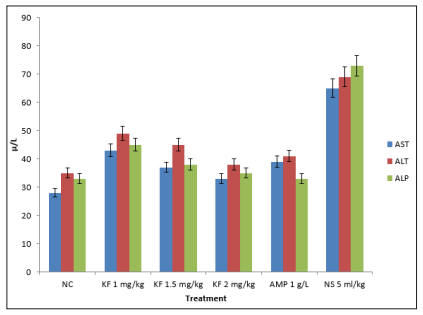
Figure 1: Effect of kaempferol on the activities of liver enzymes (ALT, AST, ALP) in two week old broilers experimentally infected with E tenella
Key: NC=Neutral control, KF=Kaempferol, AMP= Amprolium
and NS=Normal Saline
P?0.05 considered significant.
Effects of Treatments with Kaempferol on Antioxidant Enzymes
Figure 2 shows the effect of treatment with kaempferol on
antioxidant enzymes in two weeks old broilers challenged with
Eimeria tenella. Antioxidant enzymes increased significantly (P
< 0.05) in a dose dependent manner in group II, II and IV when
compared with the infected untreated group (VI)
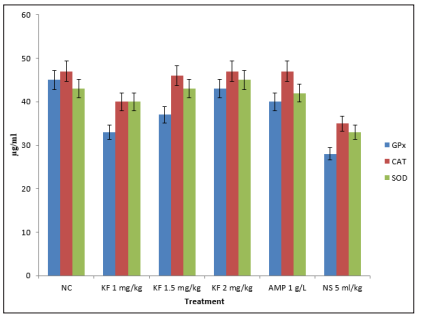
Figure 2: Effect of treatment of kaempferol on antioxidant enzymes (SOD, CAT and GPx) of two week old broilers experimentally infected with E. tenella
Effects of Kaempferol on Packed Cell Volume of Infected Broiler
Chickens
Figure 3 shows the effect of kaempferol on packed cell volume
(PCV) of two weeks old broilers challenged with Eimeria tenella.
PCV increased significantly (P < 0.05) in a dose dependent manner
in group II, II and IV when compared infected untreated group
(VI).
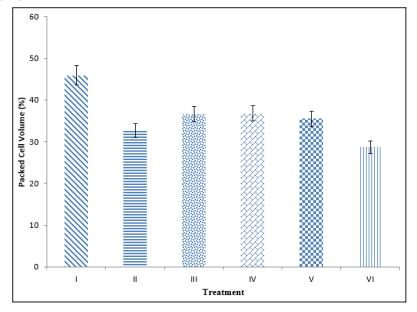
Figure 3: Effect of kaempferol on packed cell volume of two weeks old broilers challenged with Eimeria tenella
Effect of Kaempferol on Haemoglobin Concentration of Infected Broiler Chickens Figure 4 shows the effect of treatment with kaempferol on packed cell volume of two weeks old broilers challenged with Eimeria tenella. Haemoglobin concentration increased significantly (P < 0.05) in a dose dependent manner in group II, II and IV when compared infected untreated group (VI).
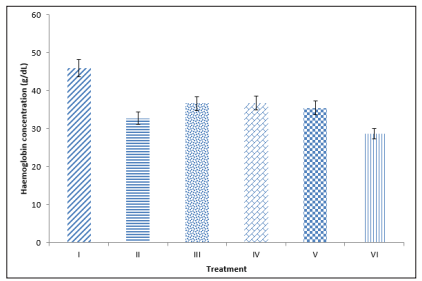
Figure 4: Effect of kaempferol on haemoglobin concentration of two weeks old broilers challenged with Eimeria tenella
Effect of Kaempferol on Red Blood Cell Count of Infected Broiler Chickens Figure 5 shows the effect of kaempferol on packed cell volume of two weeks old broilers challenged with Eimeria tenella. Red blood cell count increased significantly (P < 0.05) in a dose dependent manner in group II, II and IV when compared infected untreated group (VI).
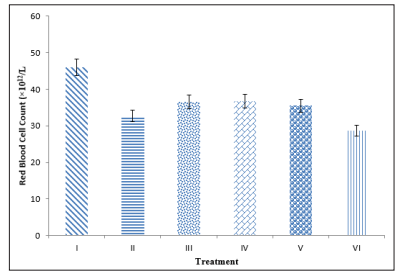
Figure 5: Effect of kaempferol on red blood cell count of two weeks old broilers challenged with Eimeria tenella
Discussions
The increased levels of ALT, AST and ALP in the infected untreated broilers agrees with the earlier reports of, who attributed the elevation of ALT, AST and ALP to inflammation in the host, particularly of the liver. Another possibility of increased levels of ALT and AST is the activities of free radicals generated at different stages of the infection [11, 12]. Therefore, serum levels of ALT and AST are two of the most useful indications of liver cell injury, although the AST is less liver specific than is ALT [13].
The increase in the serum level of GPx, CAT and SOD in the treated groups is suggestive of in vivo antioxidant enhancing capacity of kaempferol, during Eimeria infection in chickens, the innate immune system of these chickens protects them by producing reactive oxygen species (ROS) in a process termed ?oxidative burst? in an attempt to destroy the Eimeria pathogens [14]. Unfortunately, since such ROS generated are not target specific, the reactive species also damage cells of the gastrointestinal tract resulting in ulcerations [15].Kaempferol used in used in this study, possess antioxidant properties which aid in free radical scavenging and reactive oxygen quenching activities, thereby ameliorating oxidative stress mediated damage [16]
The study also revealed significant increase in the packed cell volume, haemoglobin concentration and total erythrocyte count in a dose dependent manner in groups treated with kaempferol, this indicate the erythropoietic ability of the kaempferol which is beneficial since the Eimeria parasite in the epithelia of the intestines causes bloody diarrhoea and consequently anaemia. It also agrees with the work of who reported an ameliorative effects of plant extract (Anacardium occidentale) rich in flavonoids in broilers experimental Eimeria tenella infection and they attributed the effect to the ability of antioxidant to enhance bird’s immune response against Eimeria and therefore resulted in the protective effect of antioxidant against clinical pathology caused by Eimeria tenella. Similarly, the reduced level of packed cell volume, haemoglobin concentration and total erythrocyte count in the infected untreated birds (group VI) could be due to hemorrhages in the ceca and intestine as histamine are released during tissue injury thereby increasing the permeability of blood capillaries and venules, hence allowing the exudation of large quantities of blood [17,18].
Conclusion
It was therefore concluded in this study that, the oral administration of kaempferol had ameliorated stress induced by the experimental Eimeria tenella infection in two weeks old broilers via improving the serum level of antioxidants (GPx, CAT and SOD) and liver (ALT, AST and ALP) enzymes as well as improved haematological parameters [19].
Acknowledgements
The researchers have sincerely appreciate the effort of a laboratory technologist, Yusuf Magji of the Department of Veterinary Parasitology and Entomology, A.B.U Zaria and an animal health technologist, Isma’la Gambo of the Department of Animal Health and Production, Binyaminu Usman Polytechnic, Hadejia, Jigawa State Nigeria, who have contributed immensely to the success of this work.
References
- Gilbert ER, Cox CM, Williams P M, (2011) Eimeria species and genetic background influence the serum protein profile of broilers with coccidiosis, PLoS ONE 6:
- Joyner L, Long P, (2008) the specific characters of the Eimeria, with special reference to the Coccidia of the fowl, Avian Pathology
- Chapman H D,(2014) Milestones in avian coccidiosis research: a review, Poultry Science 93:
- Quiroz-Castaeda RE, Dantn-Gonzlez E (2015) Control of avian coccidiosis: future and present natural alternatives, BioMedical Research International
- Allen P C, Danforth H D, Augustine P C (1998) Dietary modulation of avian coccidiosis. International Journal of Parasitology 28:
- Shahzad A, Mahmood MS, Hussain I, Siddique F, Abbas RZ (2012) Prevalence of salmonella species in hen eggs and egg storing-trays collected from poultry farms and marketing outlets of Faisalabad, Pakistan. Pakistan Journal of Agricultural Sciences 49:
- Misra HP, Fridivich I (1972) The role of superoxide union in auto-oxidation of epinephrine and sample assay for superoxide dismutase. Journal of Biological Chemistry 247:
- Beers RF, Sizer IW (1952) A Spsectrophotometric method for measuring the breakdown of H2O2 by catalase. Journal of Biological Chemistry 195:
- Paglia D E, Valentine WN (1967) Studies on the quantitative and qualitative characterization of erythrocyte glutathione peroxidase. Laboratory Clinical Medicine 70:
- Bampidis VA, Christodoulou V, Florou-Paneri P, Christaki E, Spais, et al. (2005) Effect of dried oregano leaves supplementation on performance and carcass characteristics of growing lambs. Animal Feed Science Technology 121:
- Coles E H (1986) Veterinary Clinical Pathology 4th edition, W.B Saunder, Philadelphia, London
- Srivastava P, Yadav N, Lella R, Schneider A, Jones A, et al (2012) Neem oil limonoids induces p53-independent apoptosis and autophagy. Carcinogenesis 33:
- Takeet MI, Fagbemi BO (2009) Haematological, Pathological and Plasma biochemical Changes in rabbits experimentally infected with trypanosoma congolense, Science World Journal
- Murali RA (2014) Liver Test Interpretation - Approach to the Patient with Liver Disease: A Guide to Commonly Used Liver Tests. Journal Centre for Continuing
- Lillehoj H S, Trout J M (1996) Avian gut-associated lymphoid tissues and intestinal immune responses to Eimeria parasites, Clinical Microbiology Reviews 9:
- Kasper L H, Buzoni-Gatel D (2001) Ups and downs of mucosal cellular immunity against protozoan parasites, Infection and Immunity 69:
- Androulakis X M, Muga S J, Chen F, Koita Y, Toure B, (2006) Chemopreventive effects of Khaya senegalensis bark extract on human colorectal cancer, Anticancer Research 26:
- Jatau I D, Andamin A D, Muhammad Y (2017) Combined effects of feed supplementation with probiotic and oral administration of methanol leaf extract of Anacardium occidentale against experimental Eimeria tenella infection in th broilers. Book of Abstract of 54 Annual Conference of Nigerian Veterinary Medical Association
- Hein H (1971) Pathogenic effects of Eimeria necatrix in young chickens. Exp Parasitol 65: 321-330.

